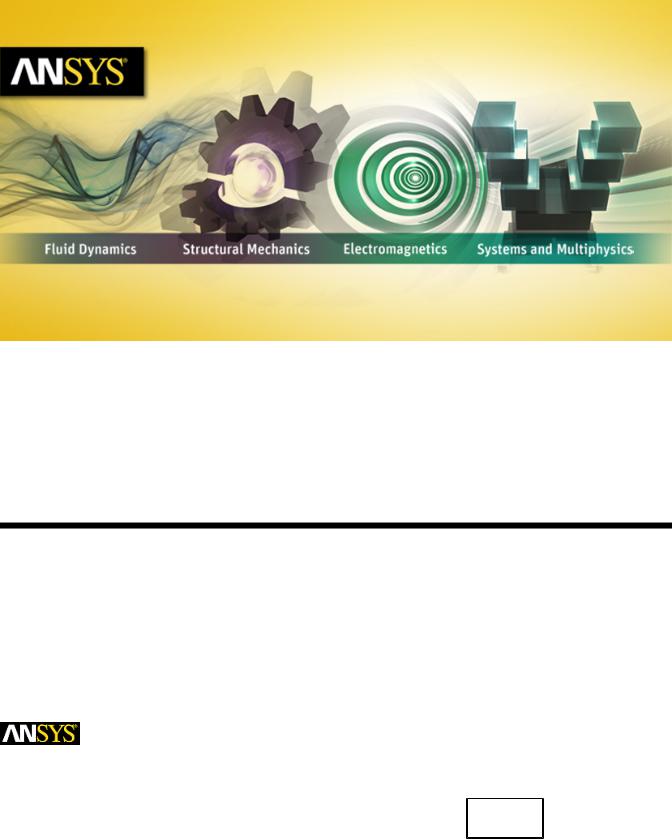
- •Table of Contents
- •Chapter 1: Probabilistic Design
- •1.1. Understanding Probabilistic Design
- •1.1.1. Traditional (Deterministic) vs. Probabilistic Design Analysis Methods
- •1.1.2. Reliability and Quality Issues
- •1.2. Probabilistic Design Terminology
- •1.3. Using Probabilistic Design
- •1.3.1. Create the Analysis File
- •1.3.1.1. Example Problem Description
- •1.3.1.2. Build the Model Parametrically
- •1.3.1.3. Obtain the Solution
- •1.3.1.4. Retrieve Results and Assign as Output Parameters
- •1.3.1.5. Prepare the Analysis File
- •1.3.2. Establish Parameters for Probabilistic Design Analysis
- •1.3.3. Enter the PDS and Specify the Analysis File
- •1.3.4. Declare Random Input Variables
- •1.3.5. Visualize Random Input Variables
- •1.3.6. Specify Correlations Between Random Variables
- •1.3.7. Specify Random Output Parameters
- •1.3.8. Select a Probabilistic Design Method
- •1.3.8.1. Probabilistic Method Determination Wizard
- •1.3.9. Execute Probabilistic Analysis Simulation Loops
- •1.3.9.1. Probabilistic Design Looping
- •1.3.9.2. Serial Analysis Runs
- •1.3.9.3. PDS Parallel Analysis Runs
- •1.3.9.3.1. Machine Configurations
- •1.3.9.3.1.1. Choosing Slave Machines
- •1.3.9.3.1.2. Using the Remote Shell Option
- •1.3.9.3.1.3. Using the Connection Port Option
- •1.3.9.3.1.4. Configuring the Master Machine
- •1.3.9.3.1.5. Host setup using port option
- •1.3.9.3.1.6. Host and Product selection for a particular analysis
- •1.3.9.3.2. Files Needed for Parallel Run
- •1.3.9.3.3. Controlling Server Processes
- •1.3.9.3.4. Initiate Parallel Run
- •1.3.10. Fit and Use Response Surfaces
- •1.3.10.1. About Response Surface Sets
- •1.3.10.2. Fitting a Response Surface
- •1.3.10.3. Plotting a Response Surface
- •1.3.10.4. Printing a Response Surface
- •1.3.10.5. Generating Monte Carlo Simulation Samples on the Response Surfaces
- •1.3.11. Review Results Data
- •1.3.11.1. Viewing Statistics
- •1.3.11.2. Viewing Trends
- •1.3.11.3. Creating Reports
- •1.4. Guidelines for Selecting Probabilistic Design Variables
- •1.4.1. Choosing and Defining Random Input Variables
- •1.4.1.1. Random Input Variables for Monte Carlo Simulations
- •1.4.1.2. Random Input Variables for Response Surface Analyses
- •1.4.1.3. Choosing a Distribution for a Random Variable
- •1.4.1.3.1. Measured Data
- •1.4.1.3.2. Mean Values, Standard Deviation, Exceedence Values
- •1.4.1.3.3. No Data
- •1.4.1.4. Distribution Functions
- •1.4.2. Choosing Random Output Parameters
- •1.5. Probabilistic Design Techniques
- •1.5.1. Monte Carlo Simulations
- •1.5.1.1. Direct Sampling
- •1.5.1.2. Latin Hypercube Sampling
- •1.5.1.3. User-Defined Sampling
- •1.5.2. Response Surface Analysis Methods
- •1.5.2.1. Central Composite Design Sampling
- •1.5.2.2. Box-Behnken Matrix Sampling
- •1.5.2.3. User-Defined Sampling
- •1.6. Postprocessing Probabilistic Analysis Results
- •1.6.1. Statistical Postprocessing
- •1.6.1.1. Sample History
- •1.6.1.2. Histogram
- •1.6.1.3. Cumulative Distribution Function
- •1.6.1.4. Print Probabilities
- •1.6.1.5. Print Inverse Probabilities
- •1.6.2. Trend Postprocessing
- •1.6.2.1. Sensitivities
- •1.6.2.2. Scatter Plots
- •1.6.2.3. Correlation Matrix
- •1.6.3. Generating an HTML Report
- •1.7. Multiple Probabilistic Design Executions
- •1.7.1. Saving the Probabilistic Design Database
- •1.7.2. Restarting a Probabilistic Design Analysis
- •1.7.3. Clearing the Probabilistic Design Database
- •1.8. Example Probabilistic Design Analysis
- •1.8.1. Problem Description
- •1.8.2. Problem Specifications
- •1.8.2.1. Problem Sketch
- •1.8.3. Using a Batch File for the Analysis
- •1.8.4. Using the GUI for the PDS Analysis
- •Chapter 2: Variational Technology
- •2.1. Harmonic Sweep Using VT Accelerator
- •2.1.1. Structural Elements Supporting Frequency-Dependent Properties
- •2.1.2. Harmonic Sweep for Structural Analysis with Frequency-Dependent Material Properties
- •2.1.2.1. Beam Example
- •Chapter 3: Adaptive Meshing
- •3.1. Prerequisites for Adaptive Meshing
- •3.2. Employing Adaptive Meshing
- •3.3. Modifying the Adaptive Meshing Process
- •3.3.1. Selective Adaptivity
- •3.3.2. Customizing the ADAPT Macro with User Subroutines
- •3.3.2.1. Creating a Custom Meshing Subroutine (ADAPTMSH.MAC)
- •3.3.2.2. Creating a Custom Subroutine for Boundary Conditions (ADAPTBC.MAC)
- •3.3.2.3. Creating a Custom Solution Subroutine (ADAPTSOL.MAC)
- •3.3.2.4. Some Further Comments on Custom Subroutines
- •3.3.3. Customizing the ADAPT Macro (UADAPT.MAC)
- •3.4. Adaptive Meshing Hints and Comments
- •3.5. Where to Find Examples
- •Chapter 4: Rezoning
- •4.1. Benefits and Limitations of Rezoning
- •4.1.1. Rezoning Limitations
- •4.2. Rezoning Requirements
- •4.3. Understanding the Rezoning Process
- •4.3.1. Overview of the Rezoning Process Flow
- •4.3.2. Key Commands Used in Rezoning
- •4.4. Step 1: Determine the Substep to Initiate Rezoning
- •4.5. Step 2. Initiate Rezoning
- •4.6. Step 3: Select a Region to Remesh
- •4.7. Step 4: Perform the Remeshing Operation
- •4.7.1. Choosing a Remeshing Method
- •4.7.1.1. Remeshing Using a Program-Generated New Mesh (2-D)
- •4.7.1.1.1. Creating an Area to Remesh
- •4.7.1.1.2. Using Nodes From the Old Mesh
- •4.7.1.1.3. Hints for Remeshing Multiple Regions
- •4.7.1.1.4. Generating a New Mesh
- •4.7.1.2. Remeshing Using a Generic New Mesh (2-D and 3-D)
- •4.7.1.2.1. Using the REMESH Command with a Generic New Mesh
- •4.7.1.2.2. Requirements for the Generic New Mesh
- •4.7.1.2.3. Using the REGE and KEEP Remeshing Options
- •4.7.1.3. Remeshing Using Manual Mesh Splitting (2-D and 3-D)
- •4.7.1.3.1. Understanding Mesh Splitting
- •4.7.1.3.2. Geometry Details for Mesh Splitting
- •4.7.1.3.3. Using the REMESH Command for Mesh Splitting
- •4.7.1.3.4. Mesh-Transition Options for 2-D Mesh Splitting
- •4.7.1.3.5. Mesh-Transition Options for 3-D Mesh Splitting
- •4.7.1.3.7. Improving Tetrahedral Element Quality via Mesh Morphing
- •4.7.2. Mesh Control
- •4.7.3. Remeshing Multiple Regions at the Same Substep
- •4.8. Step 5: Verify Applied Contact Boundaries, Surface-Effect Elements, Loads, and Boundary Conditions
- •4.8.1. Contact Boundaries
- •4.8.2. Surface-Effect Elements
- •4.8.3. Pressure and Contiguous Displacements
- •4.8.4. Forces and Isolated Applied Displacements
- •4.8.5. Nodal Temperatures
- •4.8.6. Other Boundary Conditions and Loads
- •4.9. Step 6: Automatically Map Variables and Balance Residuals
- •4.9.1. Mapping Solution Variables
- •4.9.2. Balancing Residual Forces
- •4.9.3. Interpreting Mapped Results
- •4.9.4. Handling Convergence Difficulties
- •4.10. Step 7: Perform a Multiframe Restart
- •4.11. Repeating the Rezoning Process if Necessary
- •4.11.1. File Structures for Repeated Rezonings
- •4.12. Postprocessing Rezoning Results
- •4.12.1. The Database Postprocessor
- •4.12.1.1. Listing the Rezoning Results File Summary
- •4.12.1.2. Animating the Rezoning Results
- •4.12.1.3. Using the Results Viewer for Rezoning
- •4.12.2. The Time-History Postprocessor
- •4.13. Rezoning Restrictions
- •4.14. Rezoning Examples
- •4.14.1. Example: Rezoning Using a Program-Generated New Mesh
- •4.14.1.1. Initial Input for the Analysis
- •4.14.1.2. Rezoning Input for the Analysis
- •4.14.2. Example: Rezoning Using a Generic New Mesh
- •4.14.2.1. Initial Input for the Analysis
- •4.14.2.2. Exporting the Distorted Mesh as a CDB File
- •4.14.2.3. Importing the File into ANSYS ICEM CFD and Generating a New Mesh
- •4.14.2.4. Rezoning Using the New CDB Mesh
- •Chapter 5: Mesh Nonlinear Adaptivity
- •5.1. Mesh Nonlinear Adaptivity Benefits, Limitations and Requirements
- •5.1.1. Rubber Seal Simulation
- •5.1.2. Crack Simulation
- •5.2. Understanding the Mesh Nonlinear Adaptivity Process
- •5.2.1. Checking Nonlinear Adaptivity Criteria
- •5.2.1.1. Defining Element Components
- •5.2.1.2. Defining Nonlinear Adaptivity Criteria
- •5.2.1.3. Defining Criteria-Checking Frequency
- •5.3. Mesh Nonlinear Adaptivity Criteria
- •5.3.1. Energy-Based
- •5.3.2. Position-Based
- •5.3.3. Contact-Based
- •5.3.4. Frequency of Criteria Checking
- •5.4. How a New Mesh Is Generated
- •5.5. Convergence at Substeps with the New Mesh
- •5.6. Controlling Mesh Nonlinear Adaptivity
- •5.7. Postprocessing Mesh Nonlinear Adaptivity Results
- •5.8. Mesh Nonlinear Adaptivity Examples
- •5.8.1. Example: Rubber Seal Simulation
- •5.8.2. Example: Crack Simulation
- •Chapter 6: 2-D to 3-D Analysis
- •6.1. Benefits of 2-D to 3-D Analysis
- •6.2. Requirements for a 2-D to 3-D Analysis
- •6.3. Overview of the 2-D to 3-D Analysis Process
- •6.3.1. Overview of the 2-D to 3-D Analysis Process Flow
- •6.3.2. Key Commands Used in 2-D to 3-D Analysis
- •6.4. Performing a 2-D to 3-D Analysis
- •6.4.1. Step 1: Determine the Substep to Initiate
- •6.4.2. Step 2: Initiate the 2-D to 3-D Analysis
- •6.4.3. Step 3: Extrude the 2-D Mesh to the New 3-D Mesh
- •6.4.4. Step 4: Map Solution Variables from 2-D to 3-D Mesh
- •6.4.5. Step 5: Perform an Initial-State-Based 3-D Analysis
- •6.5. 2-D to 3-D Analysis Restrictions
- •Chapter 7: Cyclic Symmetry Analysis
- •7.1. Understanding Cyclic Symmetry Analysis
- •7.1.1. How the Program Automates a Cyclic Symmetry Analysis
- •7.1.2. Commands Used in a Cyclic Symmetry Analysis
- •7.2. Cyclic Modeling
- •7.2.1. The Basic Sector
- •7.2.2. Edge Component Pairs
- •7.2.2.1. CYCOPT Auto Detection Tolerance Adjustments for Difficult Cases
- •7.2.2.2. Identical vs. Dissimilar Edge Node Patterns
- •7.2.2.3. Unmatched Nodes on Edge-Component Pairs
- •7.2.2.4. Identifying Matching Node Pairs
- •7.2.3. Modeling Limitations
- •7.2.4. Model Verification (Preprocessing)
- •7.3. Solving a Cyclic Symmetry Analysis
- •7.3.1. Understanding the Solution Architecture
- •7.3.1.1. The Duplicate Sector
- •7.3.1.2. Coupling and Constraint Equations (CEs)
- •7.3.1.3. Non-Cyclically Symmetric Loading
- •7.3.1.3.1. Specifying Non-Cyclic Loading
- •7.3.1.3.2. Commands Affected by Non-Cyclic Loading
- •7.3.1.3.3. Plotting and Listing Non-Cyclic Boundary Conditions
- •7.3.1.3.4. Graphically Picking Non-Cyclic Boundary Conditions
- •7.3.2. Solving a Static Cyclic Symmetry Analysis
- •7.3.3. Solving a Modal Cyclic Symmetry Analysis
- •7.3.3.1. Understanding Harmonic Index and Nodal Diameter
- •7.3.3.2. Solving a Stress-Free Modal Analysis
- •7.3.3.3. Solving a Prestressed Modal Analysis
- •7.3.3.4. Solving a Large-Deflection Prestressed Modal Analysis
- •7.3.3.4.1. Solving a Large-Deflection Prestressed Modal Analysis with VT Accelerator
- •7.3.4. Solving a Linear Buckling Cyclic Symmetry Analysis
- •7.3.5. Solving a Harmonic Cyclic Symmetry Analysis
- •7.3.5.1. Solving a Full Harmonic Cyclic Symmetry Analysis
- •7.3.5.1.1. Solving a Prestressed Full Harmonic Cyclic Symmetry Analysis
- •7.3.5.2. Solving a Mode-Superposition Harmonic Cyclic Symmetry Analysis
- •7.3.5.2.1. Perform a Static Cyclic Symmetry Analysis to Obtain the Prestressed State
- •7.3.5.2.2. Perform a Linear Perturbation Modal Cyclic Symmetry Analysis
- •7.3.5.2.3. Restart the Modal Analysis to Create the Desired Load Vector from Element Loads
- •7.3.5.2.4. Obtain the Mode-Superposition Harmonic Cyclic Symmetry Solution
- •7.3.5.2.5. Review the Results
- •7.3.6. Solving a Magnetic Cyclic Symmetry Analysis
- •7.3.7. Database Considerations After Obtaining the Solution
- •7.3.8. Model Verification (Solution)
- •7.4. Postprocessing a Cyclic Symmetry Analysis
- •7.4.1. General Considerations
- •7.4.1.1. Using the /CYCEXPAND Command
- •7.4.1.1.1. /CYCEXPAND Limitations
- •7.4.1.2. Result Coordinate System
- •7.4.2. Modal Solution
- •7.4.2.1. Real and Imaginary Solution Components
- •7.4.2.2. Expanding the Cyclic Symmetry Solution
- •7.4.2.3. Applying a Traveling Wave Animation to the Cyclic Model
- •7.4.2.4. Phase Sweep of Repeated Eigenvector Shapes
- •7.4.3. Static, Buckling, and Full Harmonic Solutions
- •7.4.4. Mode-Superposition Harmonic Solution
- •7.5. Example Modal Cyclic Symmetry Analysis
- •7.5.1. Problem Description
- •7.5.2. Problem Specifications
- •7.5.3. Input File for the Analysis
- •7.5.4. Analysis Steps
- •7.6. Example Buckling Cyclic Symmetry Analysis
- •7.6.1. Problem Description
- •7.6.2. Problem Specifications
- •7.6.3. Input File for the Analysis
- •7.6.4. Analysis Steps
- •7.6.5. Solve For Critical Strut Temperature at Load Factor = 1.0
- •7.7. Example Harmonic Cyclic Symmetry Analysis
- •7.7.1. Problem Description
- •7.7.2. Problem Specifications
- •7.7.3. Input File for the Analysis
- •7.7.4. Analysis Steps
- •7.8. Example Magnetic Cyclic Symmetry Analysis
- •7.8.1. Problem Description
- •7.8.2. Problem Specifications
- •7.8.3. Input file for the Analysis
- •Chapter 8: Rotating Structure Analysis
- •8.1. Understanding Rotating Structure Dynamics
- •8.2. Using a Stationary Reference Frame
- •8.2.1. Campbell Diagram
- •8.2.2. Harmonic Analysis for Unbalance or General Rotating Asynchronous Forces
- •8.2.3. Orbits
- •8.3. Using a Rotating Reference Frame
- •8.4. Choosing the Appropriate Reference Frame Option
- •8.5. Example Campbell Diagram Analysis
- •8.5.1. Problem Description
- •8.5.2. Problem Specifications
- •8.5.3. Input for the Analysis
- •8.5.4. Analysis Steps
- •8.6. Example Coriolis Analysis
- •8.6.1. Problem Description
- •8.6.2. Problem Specifications
- •8.6.3. Input for the Analysis
- •8.6.4. Analysis Steps
- •8.7. Example Unbalance Harmonic Analysis
- •8.7.1. Problem Description
- •8.7.2. Problem Specifications
- •8.7.3. Input for the Analysis
- •8.7.4. Analysis Steps
- •Chapter 9: Submodeling
- •9.1. Understanding Submodeling
- •9.1.1. Nonlinear Submodeling
- •9.2. Using Submodeling
- •9.2.1. Create and Analyze the Coarse Model
- •9.2.2. Create the Submodel
- •9.2.3. Perform Cut-Boundary Interpolation
- •9.2.4. Analyze the Submodel
- •9.3. Example Submodeling Analysis Input
- •9.3.1. Submodeling Analysis Input: No Load-History Dependency
- •9.3.2. Submodeling Analysis Input: Load-History Dependency
- •9.4. Shell-to-Solid Submodels
- •9.5. Where to Find Examples
- •Chapter 10: Substructuring
- •10.1. Benefits of Substructuring
- •10.2. Using Substructuring
- •10.2.1. Step 1: Generation Pass (Creating the Superelement)
- •10.2.1.1. Building the Model
- •10.2.1.2. Applying Loads and Creating the Superelement Matrices
- •10.2.1.2.1. Applicable Loads in a Substructure Analysis
- •10.2.2. Step 2: Use Pass (Using the Superelement)
- •10.2.2.1. Clear the Database and Specify a New Jobname
- •10.2.2.2. Build the Model
- •10.2.2.3. Apply Loads and Obtain the Solution
- •10.2.3. Step 3: Expansion Pass (Expanding Results Within the Superelement)
- •10.3. Sample Analysis Input
- •10.4. Top-Down Substructuring
- •10.5. Automatically Generating Superelements
- •10.6. Nested Superelements
- •10.7. Prestressed Substructures
- •10.7.1. Static Analysis Prestress
- •10.7.2. Substructuring Analysis Prestress
- •10.8. Where to Find Examples
- •Chapter 11: Component Mode Synthesis
- •11.1. Understanding Component Mode Synthesis
- •11.1.1. CMS Methods Supported
- •11.1.2. Solvers Used in Component Mode Synthesis
- •11.2. Using Component Mode Synthesis
- •11.2.1. The CMS Generation Pass: Creating the Superelement
- •11.2.2. The CMS Use and Expansion Passes
- •11.2.3. Superelement Expansion in Transformed Locations
- •11.2.4. Plotting or Printing Mode Shapes
- •11.3. Example Component Mode Synthesis Analysis
- •11.3.1. Problem Description
- •11.3.2. Problem Specifications
- •11.3.3. Input for the Analysis: Fixed-Interface Method
- •11.3.4. Analysis Steps: Fixed-Interface Method
- •11.3.5. Input for the Analysis: Free-Interface Method
- •11.3.6. Analysis Steps: Free-Interface Method
- •11.3.7. Input for the Analysis: Residual-Flexible Free-Interface Method
- •11.3.8. Analysis Steps: Residual-Flexible Free-Interface Method
- •11.3.9. Example: Superelement Expansion in a Transformed Location
- •11.3.9.1. Analysis Steps: Superelement Expansion in a Transformed Location
- •11.3.10. Example: Reduce the Damping Matrix and Compare Full and CMS Results with RSTMAC
- •Chapter 12: Rigid-Body Dynamics and the ANSYS-ADAMS Interface
- •12.1. Understanding the ANSYS-ADAMS Interface
- •12.2. Building the Model
- •12.3. Modeling Interface Points
- •12.4. Exporting to ADAMS
- •12.4.1. Exporting to ADAMS via Batch Mode
- •12.4.2. Verifying the Results
- •12.5. Running the ADAMS Simulation
- •12.6. Transferring Loads from ADAMS
- •12.6.1. Transferring Loads on a Rigid Body
- •12.6.1.1. Exporting Loads in ADAMS
- •12.6.1.2. Importing Loads
- •12.6.1.3. Importing Loads via Commands
- •12.6.1.4. Reviewing the Results
- •12.6.2. Transferring the Loads of a Flexible Body
- •12.7. Methodology Behind the ANSYS-ADAMS Interface
- •12.7.1. The Modal Neutral File
- •12.7.2. Adding Weak Springs
- •12.8. Example Rigid-Body Dynamic Analysis
- •12.8.1. Problem Description
- •12.8.2. Problem Specifications
- •12.8.3. Command Input
- •Chapter 13: Element Birth and Death
- •13.1. Elements Supporting Birth and Death
- •13.2. Understanding Element Birth and Death
- •13.3. Element Birth and Death Usage Hints
- •13.3.1. Changing Material Properties
- •13.4. Using Birth and Death
- •13.4.1. Build the Model
- •13.4.2. Apply Loads and Obtain the Solution
- •13.4.2.1. Define the First Load Step
- •13.4.2.1.1. Sample Input for First Load Step
- •13.4.2.2. Define Subsequent Load Steps
- •13.4.2.2.1. Sample Input for Subsequent Load Steps
- •13.4.3. Review the Results
- •13.4.4. Use Analysis Results to Control Birth and Death
- •13.4.4.1. Sample Input for Deactivating Elements
- •13.5. Where to Find Examples
- •Chapter 14: User-Programmable Features and Nonstandard Uses
- •14.1. User-Programmable Features (UPFs)
- •14.1.1. Understanding UPFs
- •14.1.2. Types of UPFs Available
- •14.2. Nonstandard Uses of the ANSYS Program
- •14.2.1. What Are Nonstandard Uses?
- •14.2.2. Hints for Nonstandard Use of ANSYS
- •Chapter 15: State-Space Matrices Export
- •15.1. State-Space Matrices Based on Modal Analysis
- •15.1.1. Examples of SPMWRITE Command Usage
- •15.1.2. Example of Reduced Model Generation in ANSYS and Usage in Simplorer
- •15.1.2.1. Problem Description
- •15.1.2.2. Problem Specifications
- •15.1.2.3. Input File for the Analysis
- •Chapter 16: Soil-Pile-Structure Analysis
- •16.1. Soil-Pile-Structure Interaction Analysis
- •16.1.1. Automatic Pile Subdivision
- •16.1.2. Convergence Criteria
- •16.1.3. Soil Representation
- •16.1.4. Mudslides
- •16.1.5. Soil-Pile Interaction Results
- •16.1.5.1. Displacements and Reactions
- •16.1.5.2. Forces and Stresses
- •16.1.5.3. UNITY Check Data
- •16.2. Soil Data Definition and Examples
- •16.2.1. Soil Profile Data Definition
- •16.2.1.1. Mudline Position Definition
- •16.2.1.2. Common Factors for P-Y, T-Z Curves
- •16.2.1.3. Horizontal Soil Properties (P-Y)
- •16.2.1.3.1. P-Y curves defined explicitly
- •16.2.1.3.2. P-Y curves generated from given soil properties
- •16.2.1.4. Vertical Soil Properties (T-Z)
- •16.2.1.4.1. T-Z curves defined explicitly
- •16.2.1.4.2. T-Z curves generated from given soil properties
- •16.2.1.5. End Bearing Properties (ENDB)
- •16.2.1.5.1. ENDB curve defined explicitly
- •16.2.1.5.2. ENDB curves generated from given soil properties
- •16.2.1.6. Mudslide Definition
- •16.2.2. Soil Data File Examples
- •16.2.2.1. Example 1: Constant Linear Soil
- •16.2.2.2. Example 2: Non-Linear Soil
- •16.2.2.3. Example 3: Soil Properties Defined in 5 Layers
- •16.2.2.4. Example 4: Soil Properties Defined in 5 Layers with Mudslide
- •16.3. Performing a Soil-Pile Interaction Analysis
- •16.3.2. Mechanical APDL Component System Example
- •16.3.3. Static Structural Component System Example
- •16.4. Soil-Pile-Structure Results
- •16.5. References
- •Chapter 17: Coupling to External Aeroelastic Analysis of Wind Turbines
- •17.1. Sequential Coupled Wind Turbine Solution in Mechanical APDL
- •17.1.1. Procedure for a Sequentially Coupled Wind Turbine Analysis
- •17.1.2. Output from the OUTAERO Command
- •Chapter 18: Applying Ocean Loading from a Hydrodynamic Analysis
- •18.1. How Hydrodynamic Analysis Data Is Used
- •18.2. Hydrodynamic Load Transfer with Forward Speed
- •18.3. Hydrodynamic Data File Format
- •18.3.1. Comment (Optional)
- •18.3.2. General Model Data
- •18.3.3. Hydrodynamic Surface Geometry
- •18.3.4. Wave Periods
- •18.3.5. Wave Directions
- •18.3.6. Panel Pressures
- •18.3.7. Morison Element Hydrodynamic Definition
- •18.3.8. Morison Element Wave Kinematics Definition
- •18.3.9. RAO Definition
- •18.3.10. Mass Properties
- •18.4. Example Analysis Using Results from a Hydrodynamic Diffraction Analysis
- •Index
- •ОГЛАВЛЕНИЕ
- •ВВЕДЕНИЕ
- •1.1. Методология проектирования технологических объектов
- •1.2. Компьютерные технологии проектирования
- •1.3. Системы автоматизированного проектирования в технике
- •1.4. Системы инженерного анализа
- •2.2.1. Создание и сохранение чертежа
- •2.2.2. Изменение параметров чертежа
- •2.2.3. Заполнение основной надписи
- •2.2.4. Создание нового вида. Локальная система координат
- •2.2.5. Вычерчивание изображения прокладки
- •2.2.6. Простановка размеров
- •2.2.7. Ввод технических требований
- •2.2.8. Задание материала изделия
- •2.3. Сложные разрезы в чертеже детали «Основание»
- •2.3.1. Подготовка чертежа
- •Cохранить документ.
- •2.3.2. Черчение по сетке из вспомогательных линий
- •2.3.3. Изображение разрезов
- •2.4. Чертежи общего вида при проектировании
- •3.1. Интерфейс программы
- •3.2. Общее представление о трехмерном моделировании
- •3.3. Основные операции геометрического моделирования
- •3.3.1. Операция выдавливания
- •3.3.2. Операция вращения
- •3.3.3. Кинематическая операция
- •3.3.4. Построение тела по сечениям
- •3.4. Операции конструирования
- •3.4.1. Построение фасок и скруглений
- •3.4.2. Построение уклона
- •3.4.3. Сечение модели плоскостью
- •3.4.4. Сечение по эскизу
- •3.4.5. Создание моделей-сборок
- •3.5. Разработка электронных 3D-моделей тепловых устройств
- •3.5.1. Электронные модели в ЕСКД
- •3.5.2. Электронные «чертежи» в ЕСКД
- •3.5.4. Электронная модель сборочного изделия «Газовая горелка»
- •ГЛАВА 4. ИНЖЕНЕРНЫЙ АНАЛИЗ ГАЗОДИНАМИКИ И ТЕПЛООБМЕНА В ANSYS CFX
- •4.1. Область применения ANSYS CFX
- •4.2. Особенности вычислительного процесса в ANSYS CFX
- •4.3. Программы, используемые при расчетах в ANSYS CFX
- •4.4. Организация процесса вычислений в среде пакета Workbench
- •4.4.1. Графический интерфейс пользователя
- •5.1. Постановка теплофизических задач в ANSYS Multiphysics
- •5.2. Решение задач в пакете ANSYS Multiphysics
- •5.2.1. Графический интерфейс пользователя
- •5.2.2. Этапы препроцессорной подготовки решения
- •5.2.3. Этап получения решения и постпроцессорной обработки результатов
- •5.3.5. Нестационарный теплообмен. Нагрев пластины в печи с жидким теплоносителем
- •5.4.1. Температурные напряжения при нагреве
- •БИБЛИОГРАФИЧЕСКИЙ СПИСОК

vk.com/club152685050 | vk.com/id446425943
ANSYS Mechanical APDL Advanced Analysis
Guide
ANSYS, Inc. |
Release 15.0 |
Southpointe |
November 2013 |
275 Technology Drive |
|
Canonsburg, PA 15317 |
ANSYS, Inc. is |
ansysinfo@ansys.com |
certified to ISO |
http://www.ansys.com |
9001:2008. |
|
|
(T) 724-746-3304 |
|
(F) 724-514-9494 |
|

vk.com/club152685050 | vk.com/id446425943
Copyright and Trademark Information
© 2013 SAS IP, Inc. All rights reserved. Unauthorized use, distribution or duplication is prohibited.
ANSYS, ANSYS Workbench, Ansoft, AUTODYN, EKM, Engineering Knowledge Manager, CFX, FLUENT, HFSS and any and all ANSYS, Inc. brand, product, service and feature names, logos and slogans are registered trademarks or trademarks of ANSYS, Inc. or its subsidiaries in the United States or other countries. ICEM CFD is a trademark used by ANSYS, Inc. under license. CFX is a trademark of Sony Corporation in Japan. All other brand, product, service and feature names or trademarks are the property of their respective owners.
Disclaimer Notice
THIS ANSYS SOFTWARE PRODUCT AND PROGRAM DOCUMENTATION INCLUDE TRADE SECRETS AND ARE CONFIDENTIAL AND PROPRIETARY PRODUCTS OF ANSYS, INC., ITS SUBSIDIARIES, OR LICENSORS. The software products and documentation are furnished by ANSYS, Inc., its subsidiaries, or affiliates under a software license agreement that contains provisions concerning non-disclosure, copying, length and nature of use, compliance with exporting laws, warranties, disclaimers, limitations of liability, and remedies, and other provisions. The software products
and documentation may be used, disclosed, transferred, or copied only in accordance with the terms and conditions of that software license agreement.
ANSYS, Inc. is certified to ISO 9001:2008.
U.S. Government Rights
For U.S. Government users, except as specifically granted by the ANSYS, Inc. software license agreement, the use, duplication, or disclosure by the United States Government is subject to restrictions stated in the ANSYS, Inc. software license agreement and FAR 12.212 (for non-DOD licenses).
Third-Party Software
See the legal information in the product help files for the complete Legal Notice for ANSYS proprietary software and third-party software. If you are unable to access the Legal Notice, please contact ANSYS, Inc.
Published in the U.S.A.

vk.com/club152685050 | vk.com/id446425943
Table of Contents |
|
1. Probabilistic Design ................................................................................................................................ |
1 |
1.1. Understanding Probabilistic Design .................................................................................................. |
1 |
1.1.1. Traditional (Deterministic) vs. Probabilistic Design Analysis Methods ......................................... |
2 |
1.1.2. Reliability and Quality Issues .................................................................................................... |
3 |
1.2. Probabilistic Design Terminology ...................................................................................................... |
3 |
1.3. Using Probabilistic Design ................................................................................................................. |
8 |
1.3.1. Create the Analysis File ............................................................................................................. |
9 |
1.3.1.1. Example Problem Description ........................................................................................ |
10 |
1.3.1.2. Build the Model Parametrically ....................................................................................... |
10 |
1.3.1.3. Obtain the Solution ....................................................................................................... |
11 |
1.3.1.4. Retrieve Results and Assign as Output Parameters .......................................................... |
11 |
1.3.1.5. Prepare the Analysis File ................................................................................................ |
12 |
1.3.2. Establish Parameters for Probabilistic Design Analysis ............................................................. |
12 |
1.3.3. Enter the PDS and Specify the Analysis File ............................................................................. |
13 |
1.3.4. Declare Random Input Variables ............................................................................................. |
14 |
1.3.5. Visualize Random Input Variables ........................................................................................... |
20 |
1.3.6. Specify Correlations Between Random Variables ..................................................................... |
20 |
1.3.7. Specify Random Output Parameters ....................................................................................... |
23 |
1.3.8. Select a Probabilistic Design Method ...................................................................................... |
24 |
1.3.8.1. Probabilistic Method Determination Wizard ................................................................... |
24 |
1.3.9. Execute Probabilistic Analysis Simulation Loops ...................................................................... |
25 |
1.3.9.1. Probabilistic Design Looping ......................................................................................... |
26 |
1.3.9.2. Serial Analysis Runs ....................................................................................................... |
27 |
1.3.9.3. PDS Parallel Analysis Runs .............................................................................................. |
27 |
1.3.9.3.1. Machine Configurations ........................................................................................ |
29 |
1.3.9.3.1.1. Choosing Slave Machines ............................................................................. |
29 |
1.3.9.3.1.2. Using the Remote Shell Option ..................................................................... |
29 |
1.3.9.3.1.3. Using the Connection Port Option ................................................................ |
31 |
1.3.9.3.1.4. Configuring the Master Machine ................................................................... |
33 |
1.3.9.3.1.5. Host setup using port option ........................................................................ |
35 |
1.3.9.3.1.6. Host and Product selection for a particular analysis ....................................... |
35 |
1.3.9.3.2. Files Needed for Parallel Run ................................................................................. |
36 |
1.3.9.3.3. Controlling Server Processes ................................................................................. |
37 |
1.3.9.3.4. Initiate Parallel Run ............................................................................................... |
38 |
1.3.10. Fit and Use Response Surfaces .............................................................................................. |
38 |
1.3.10.1. About Response Surface Sets ....................................................................................... |
39 |
1.3.10.2. Fitting a Response Surface ........................................................................................... |
39 |
1.3.10.3. Plotting a Response Surface ......................................................................................... |
40 |
1.3.10.4. Printing a Response Surface ......................................................................................... |
40 |
1.3.10.5. Generating Monte Carlo Simulation Samples on the Response Surfaces ........................ |
41 |
1.3.11. Review Results Data ............................................................................................................. |
41 |
1.3.11.1. Viewing Statistics ......................................................................................................... |
42 |
1.3.11.2. Viewing Trends ............................................................................................................ |
43 |
1.3.11.3. Creating Reports .......................................................................................................... |
44 |
1.4. Guidelines for Selecting Probabilistic Design Variables ..................................................................... |
44 |
1.4.1. Choosing and Defining Random Input Variables ..................................................................... |
44 |
1.4.1.1. Random Input Variables for Monte Carlo Simulations ..................................................... |
45 |
1.4.1.2. Random Input Variables for Response Surface Analyses .................................................. |
45 |
1.4.1.3. Choosing a Distribution for a Random Variable ............................................................... |
45 |
1.4.1.3.1. Measured Data ..................................................................................................... |
45 |
Release 15.0 - © SAS IP, Inc. All rights reserved. - Contains proprietary and confidential information |
|
of ANSYS, Inc. and its subsidiaries and affiliates. |
iii |

vk.com/club152685050Advan ed Analysis Guide | vk.com/id446425943
1.4.1.3.2. Mean Values, Standard Deviation, Exceedence Values ............................................. |
46 |
1.4.1.3.3. No Data ................................................................................................................ |
46 |
1.4.1.4. Distribution Functions ................................................................................................... |
49 |
1.4.2. Choosing Random Output Parameters .................................................................................... |
50 |
1.5. Probabilistic Design Techniques ...................................................................................................... |
51 |
1.5.1. Monte Carlo Simulations ........................................................................................................ |
51 |
1.5.1.1. Direct Sampling ............................................................................................................. |
51 |
1.5.1.2. Latin Hypercube Sampling ............................................................................................. |
52 |
1.5.1.3. User-Defined Sampling .................................................................................................. |
53 |
1.5.2. Response Surface Analysis Methods ....................................................................................... |
55 |
1.5.2.1. Central Composite Design Sampling .............................................................................. |
56 |
1.5.2.2. Box-Behnken Matrix Sampling ....................................................................................... |
58 |
1.5.2.3. User-Defined Sampling .................................................................................................. |
58 |
1.6. Postprocessing Probabilistic Analysis Results ................................................................................... |
59 |
1.6.1. Statistical Postprocessing ....................................................................................................... |
59 |
1.6.1.1. Sample History .............................................................................................................. |
59 |
1.6.1.2. Histogram ..................................................................................................................... |
60 |
1.6.1.3. Cumulative Distribution Function .................................................................................. |
60 |
1.6.1.4. Print Probabilities .......................................................................................................... |
62 |
1.6.1.5. Print Inverse Probabilities ............................................................................................... |
62 |
1.6.2. Trend Postprocessing ............................................................................................................. |
62 |
1.6.2.1. Sensitivities ................................................................................................................... |
62 |
1.6.2.2. Scatter Plots .................................................................................................................. |
65 |
1.6.2.3. Correlation Matrix .......................................................................................................... |
67 |
1.6.3. Generating an HTML Report ................................................................................................... |
67 |
1.7. Multiple Probabilistic Design Executions ......................................................................................... |
67 |
1.7.1. Saving the Probabilistic Design Database ................................................................................ |
68 |
1.7.2. Restarting a Probabilistic Design Analysis ............................................................................... |
68 |
1.7.3. Clearing the Probabilistic Design Database ............................................................................. |
69 |
1.8. Example Probabilistic Design Analysis ............................................................................................. |
69 |
1.8.1. Problem Description .............................................................................................................. |
69 |
1.8.2. Problem Specifications ........................................................................................................... |
69 |
1.8.2.1. Problem Sketch ............................................................................................................. |
70 |
1.8.3. Using a Batch File for the Analysis ........................................................................................... |
70 |
1.8.4. Using the GUI for the PDS Analysis .......................................................................................... |
72 |
2. Variational Technology ......................................................................................................................... |
75 |
2.1. Harmonic Sweep Using VT Accelerator ............................................................................................ |
75 |
2.1.1. Structural Elements Supporting Frequency-Dependent Properties .......................................... |
76 |
2.1.2. Harmonic Sweep for Structural Analysis with Frequency-Dependent Material Properties ......... |
76 |
2.1.2.1. Beam Example ............................................................................................................... |
77 |
3. Adaptive Meshing ................................................................................................................................. |
79 |
3.1. Prerequisites for Adaptive Meshing ................................................................................................. |
79 |
3.2. Employing Adaptive Meshing ......................................................................................................... |
79 |
3.3. Modifying the Adaptive Meshing Process ........................................................................................ |
80 |
3.3.1. Selective Adaptivity ............................................................................................................... |
80 |
3.3.2. Customizing the ADAPT Macro with User Subroutines ............................................................ |
81 |
3.3.2.1. Creating a Custom Meshing Subroutine (ADAPTMSH.MAC) ............................................ |
81 |
3.3.2.2. Creating a Custom Subroutine for Boundary Conditions (ADAPTBC.MAC) ....................... |
82 |
3.3.2.3. Creating a Custom Solution Subroutine (ADAPTSOL.MAC) .............................................. |
82 |
3.3.2.4. Some Further Comments on Custom Subroutines .......................................................... |
82 |
3.3.3. Customizing the ADAPT Macro (UADAPT.MAC) ....................................................................... |
83 |
3.4. Adaptive Meshing Hints and Comments .......................................................................................... |
83 |
|
Release 15.0 - © SAS IP, Inc. All rights reserved. - Contains proprietary and confidential information |
iv |
of ANSYS, Inc. and its subsidiaries and affiliates. |

vk.com/club152685050 | vk.com/id446425943 |
Advanced Analysis Guide |
3.5. Where to Find Examples .................................................................................................................. |
84 |
4. Rezoning ............................................................................................................................................... |
87 |
4.1. Benefits and Limitations of Rezoning ............................................................................................... |
87 |
4.1.1. Rezoning Limitations .............................................................................................................. |
89 |
4.2. Rezoning Requirements .................................................................................................................. |
90 |
4.3. Understanding the Rezoning Process .............................................................................................. |
92 |
4.3.1. Overview of the Rezoning Process Flow .................................................................................. |
93 |
4.3.2. Key Commands Used in Rezoning .......................................................................................... |
96 |
4.4. Step 1: Determine the Substep to Initiate Rezoning .......................................................................... |
97 |
4.5. Step 2. Initiate Rezoning .................................................................................................................. |
98 |
4.6. Step 3: Select a Region to Remesh ................................................................................................... |
98 |
4.7. Step 4: Perform the Remeshing Operation ....................................................................................... |
99 |
4.7.1. Choosing a Remeshing Method .............................................................................................. |
99 |
4.7.1.1. Remeshing Using a Program-Generated New Mesh (2-D) .............................................. |
100 |
4.7.1.1.1. Creating an Area to Remesh ................................................................................ |
100 |
4.7.1.1.2. Using Nodes From the Old Mesh ......................................................................... |
100 |
4.7.1.1.3. Hints for Remeshing Multiple Regions ................................................................ |
101 |
4.7.1.1.4. Generating a New Mesh ..................................................................................... |
101 |
4.7.1.2. Remeshing Using a Generic New Mesh (2-D and 3-D) ................................................... |
101 |
4.7.1.2.1. Using the REMESH Command with a Generic New Mesh ...................................... |
102 |
4.7.1.2.2. Requirements for the Generic New Mesh ............................................................. |
102 |
4.7.1.2.3. Using the REGE and KEEP Remeshing Options ..................................................... |
103 |
4.7.1.3. Remeshing Using Manual Mesh Splitting (2-D and 3-D) ................................................ |
105 |
4.7.1.3.1. Understanding Mesh Splitting ............................................................................. |
105 |
4.7.1.3.2. Geometry Details for Mesh Splitting ................................................................... |
105 |
4.7.1.3.3. Using the REMESH Command for Mesh Splitting .................................................. |
108 |
4.7.1.3.4. Mesh-Transition Options for 2-D Mesh Splitting ................................................... |
108 |
4.7.1.3.5. Mesh-Transition Options for 3-D Mesh Splitting ................................................... |
110 |
4.7.1.3.6. Improving the Local Topology of Tetrahedral Meshes via Edge and Face Swap- |
|
ping ................................................................................................................................. |
112 |
4.7.1.3.7. Improving Tetrahedral Element Quality via Mesh Morphing ................................. |
113 |
4.7.2. Mesh Control ....................................................................................................................... |
114 |
4.7.3. Remeshing Multiple Regions at the Same Substep ................................................................ |
115 |
4.8. Step 5: Verify Applied Contact Boundaries, Surface-Effect Elements, Loads, and Boundary Condi- |
|
tions ................................................................................................................................................... |
116 |
4.8.1. Contact Boundaries .............................................................................................................. |
116 |
4.8.2. Surface-Effect Elements ....................................................................................................... |
116 |
4.8.3. Pressure and Contiguous Displacements ............................................................................... |
116 |
4.8.4. Forces and Isolated Applied Displacements ........................................................................... |
117 |
4.8.5. Nodal Temperatures ............................................................................................................. |
117 |
4.8.6. Other Boundary Conditions and Loads ................................................................................. |
117 |
4.9. Step 6: Automatically Map Variables and Balance Residuals ............................................................ |
118 |
4.9.1. Mapping Solution Variables .................................................................................................. |
118 |
4.9.2. Balancing Residual Forces ..................................................................................................... |
118 |
4.9.3. Interpreting Mapped Results ................................................................................................ |
119 |
4.9.4. Handling Convergence Difficulties ........................................................................................ |
120 |
4.10. Step 7: Perform a Multiframe Restart ............................................................................................ |
120 |
4.11. Repeating the Rezoning Process if Necessary ............................................................................... |
120 |
4.11.1. File Structures for Repeated Rezonings ............................................................................... |
121 |
4.12. Postprocessing Rezoning Results ................................................................................................. |
121 |
4.12.1. The Database Postprocessor ............................................................................................... |
121 |
4.12.1.1. Listing the Rezoning Results File Summary ................................................................. |
122 |
Release 15.0 - © SAS IP, Inc. All rights reserved. - Contains proprietary and confidential information |
|
of ANSYS, Inc. and its subsidiaries and affiliates. |
v |

vk.com/club152685050Advan ed Analysis Guide | vk.com/id446425943
4.12.1.2. Animating the Rezoning Results ................................................................................. |
122 |
4.12.1.3. Using the Results Viewer for Rezoning ........................................................................ |
122 |
4.12.2. The Time-History Postprocessor .......................................................................................... |
123 |
4.13. Rezoning Restrictions .................................................................................................................. |
123 |
4.14. Rezoning Examples ..................................................................................................................... |
124 |
4.14.1. Example: Rezoning Using a Program-Generated New Mesh ................................................. |
124 |
4.14.1.1. Initial Input for the Analysis ........................................................................................ |
125 |
4.14.1.2. Rezoning Input for the Analysis .................................................................................. |
127 |
4.14.2. Example: Rezoning Using a Generic New Mesh .................................................................... |
127 |
4.14.2.1. Initial Input for the Analysis ........................................................................................ |
128 |
4.14.2.2. Exporting the Distorted Mesh as a CDB File ................................................................ |
130 |
4.14.2.3. Importing the File into ANSYS ICEM CFD and Generating a New Mesh ......................... |
131 |
4.14.2.4. Rezoning Using the New CDB Mesh ........................................................................... |
132 |
5. Mesh Nonlinear Adaptivity ................................................................................................................. |
135 |
5.1. Mesh Nonlinear Adaptivity Benefits, Limitations and Requirements ................................................ |
135 |
5.1.1. Rubber Seal Simulation ........................................................................................................ |
136 |
5.1.2. Crack Simulation .................................................................................................................. |
139 |
5.2. Understanding the Mesh Nonlinear Adaptivity Process .................................................................. |
142 |
5.2.1. Checking Nonlinear Adaptivity Criteria ................................................................................. |
143 |
5.2.1.1. Defining Element Components .................................................................................... |
143 |
5.2.1.2. Defining Nonlinear Adaptivity Criteria .......................................................................... |
144 |
5.2.1.3. Defining Criteria-Checking Frequency .......................................................................... |
144 |
5.3. Mesh Nonlinear Adaptivity Criteria ................................................................................................ |
144 |
5.3.1. Energy-Based ....................................................................................................................... |
144 |
5.3.2. Position-Based ..................................................................................................................... |
144 |
5.3.3. Contact-Based ...................................................................................................................... |
145 |
5.3.4. Frequency of Criteria Checking ............................................................................................. |
145 |
5.4. How a New Mesh Is Generated ...................................................................................................... |
146 |
5.5. Convergence at Substeps with the New Mesh ................................................................................ |
149 |
5.6. Controlling Mesh Nonlinear Adaptivity .......................................................................................... |
150 |
5.7. Postprocessing Mesh Nonlinear Adaptivity Results ........................................................................ |
150 |
5.8. Mesh Nonlinear Adaptivity Examples ............................................................................................. |
150 |
5.8.1. Example: Rubber Seal Simulation .......................................................................................... |
151 |
5.8.2. Example: Crack Simulation .................................................................................................... |
153 |
6. 2-D to 3-D Analysis .............................................................................................................................. |
155 |
6.1. Benefits of 2-D to 3-D Analysis ....................................................................................................... |
155 |
6.2. Requirements for a 2-D to 3-D Analysis ......................................................................................... |
155 |
6.3. Overview of the 2-D to 3-D Analysis Process .................................................................................. |
157 |
6.3.1. Overview of the 2-D to 3-D Analysis Process Flow .................................................................. |
157 |
6.3.2. Key Commands Used in 2-D to 3-D Analysis .......................................................................... |
158 |
6.4. Performing a 2-D to 3-D Analysis ................................................................................................... |
159 |
6.4.1. Step 1: Determine the Substep to Initiate .............................................................................. |
159 |
6.4.2. Step 2: Initiate the 2-D to 3-D Analysis ................................................................................... |
160 |
6.4.3. Step 3: Extrude the 2-D Mesh to the New 3-D Mesh .............................................................. |
160 |
6.4.4. Step 4: Map Solution Variables from 2-D to 3-D Mesh ............................................................. |
161 |
6.4.5. Step 5: Perform an Initial-State-Based 3-D Analysis ................................................................ |
161 |
6.5. 2-D to 3-D Analysis Restrictions ..................................................................................................... |
161 |
7. Cyclic Symmetry Analysis .................................................................................................................... |
163 |
7.1. Understanding Cyclic Symmetry Analysis ...................................................................................... |
163 |
7.1.1. How the Program Automates a Cyclic Symmetry Analysis ...................................................... |
163 |
7.1.2. Commands Used in a Cyclic Symmetry Analysis ..................................................................... |
164 |
7.2. Cyclic Modeling ............................................................................................................................ |
164 |
|
Release 15.0 - © SAS IP, Inc. All rights reserved. - Contains proprietary and confidential information |
vi |
of ANSYS, Inc. and its subsidiaries and affiliates. |

vk.com/club152685050 | vk.com/id446425943 |
Advanced Analysis Guide |
7.2.1. The Basic Sector ................................................................................................................... |
165 |
7.2.2. Edge Component Pairs ......................................................................................................... |
166 |
7.2.2.1. CYCOPT Auto Detection Tolerance Adjustments for Difficult Cases ............................... |
166 |
7.2.2.2. Identical vs. Dissimilar Edge Node Patterns ................................................................... |
169 |
7.2.2.3. Unmatched Nodes on Edge-Component Pairs .............................................................. |
170 |
7.2.2.4. Identifying Matching Node Pairs .................................................................................. |
170 |
7.2.3. Modeling Limitations ........................................................................................................... |
170 |
7.2.4. Model Verification (Preprocessing) ........................................................................................ |
171 |
7.3. Solving a Cyclic Symmetry Analysis ............................................................................................... |
171 |
7.3.1. Understanding the Solution Architecture .............................................................................. |
171 |
7.3.1.1. The Duplicate Sector .................................................................................................... |
171 |
7.3.1.2. Coupling and Constraint Equations (CEs) ...................................................................... |
172 |
7.3.1.3. Non-Cyclically Symmetric Loading ............................................................................... |
173 |
7.3.1.3.1. Specifying Non-Cyclic Loading ............................................................................ |
174 |
7.3.1.3.2. Commands Affected by Non-Cyclic Loading ........................................................ |
176 |
7.3.1.3.3. Plotting and Listing Non-Cyclic Boundary Conditions ........................................... |
176 |
7.3.1.3.4. Graphically Picking Non-Cyclic Boundary Conditions ........................................... |
176 |
7.3.2. Solving a Static Cyclic Symmetry Analysis .............................................................................. |
176 |
7.3.3. Solving a Modal Cyclic Symmetry Analysis ............................................................................ |
178 |
7.3.3.1. Understanding Harmonic Index and Nodal Diameter .................................................... |
178 |
7.3.3.2. Solving a Stress-Free Modal Analysis ............................................................................ |
179 |
7.3.3.3. Solving a Prestressed Modal Analysis ............................................................................ |
180 |
7.3.3.4. Solving a Large-Deflection Prestressed Modal Analysis ................................................. |
181 |
7.3.3.4.1. Solving a Large-Deflection Prestressed Modal Analysis with VT Accelerator .......... |
183 |
7.3.4. Solving a Linear Buckling Cyclic Symmetry Analysis ............................................................... |
183 |
7.3.5. Solving a Harmonic Cyclic Symmetry Analysis ....................................................................... |
184 |
7.3.5.1. Solving a Full Harmonic Cyclic Symmetry Analysis ........................................................ |
184 |
7.3.5.1.1. Solving a Prestressed Full Harmonic Cyclic Symmetry Analysis ............................. |
185 |
7.3.5.2. Solving a Mode-Superposition Harmonic Cyclic Symmetry Analysis .............................. |
186 |
7.3.5.2.1. Perform a Static Cyclic Symmetry Analysis to Obtain the Prestressed State ............ |
187 |
7.3.5.2.2. Perform a Linear Perturbation Modal Cyclic Symmetry Analysis ............................ |
188 |
7.3.5.2.3. Restart the Modal Analysis to Create the Desired Load Vector from Element |
|
Loads ............................................................................................................................... |
188 |
7.3.5.2.4. Obtain the Mode-Superposition Harmonic Cyclic Symmetry Solution ................... |
189 |
7.3.5.2.5. Review the Results .............................................................................................. |
190 |
7.3.6. Solving a Magnetic Cyclic Symmetry Analysis ........................................................................ |
191 |
7.3.7. Database Considerations After Obtaining the Solution .......................................................... |
192 |
7.3.8. Model Verification (Solution) ................................................................................................. |
192 |
7.4. Postprocessing a Cyclic Symmetry Analysis .................................................................................... |
193 |
7.4.1. General Considerations ........................................................................................................ |
193 |
7.4.1.1. Using the /CYCEXPAND Command ............................................................................... |
193 |
7.4.1.1.1. /CYCEXPAND Limitations ..................................................................................... |
194 |
7.4.1.2. Result Coordinate System ............................................................................................ |
194 |
7.4.2. Modal Solution ..................................................................................................................... |
195 |
7.4.2.1. Real and Imaginary Solution Components .................................................................... |
195 |
7.4.2.2. Expanding the Cyclic Symmetry Solution ..................................................................... |
196 |
7.4.2.3. Applying a Traveling Wave Animation to the Cyclic Model ............................................. |
196 |
7.4.2.4. Phase Sweep of Repeated Eigenvector Shapes ............................................................. |
197 |
7.4.3. Static, Buckling, and Full Harmonic Solutions ......................................................................... |
198 |
7.4.4. Mode-Superposition Harmonic Solution ............................................................................... |
198 |
7.5. Example Modal Cyclic Symmetry Analysis ...................................................................................... |
198 |
7.5.1. Problem Description ............................................................................................................. |
199 |
Release 15.0 - © SAS IP, Inc. All rights reserved. - Contains proprietary and confidential information |
|
of ANSYS, Inc. and its subsidiaries and affiliates. |
vii |

vk.com/club152685050Advan ed Analysis Guide | vk.com/id446425943
7.5.2. Problem Specifications ......................................................................................................... |
199 |
7.5.3. Input File for the Analysis ...................................................................................................... |
200 |
7.5.4. Analysis Steps ...................................................................................................................... |
202 |
7.6. Example Buckling Cyclic Symmetry Analysis .................................................................................. |
203 |
7.6.1. Problem Description ............................................................................................................. |
203 |
7.6.2. Problem Specifications ......................................................................................................... |
203 |
7.6.3. Input File for the Analysis ...................................................................................................... |
204 |
7.6.4. Analysis Steps ...................................................................................................................... |
207 |
7.6.5. Solve For Critical Strut Temperature at Load Factor = 1.0 ........................................................ |
208 |
7.7. Example Harmonic Cyclic Symmetry Analysis ................................................................................. |
210 |
7.7.1. Problem Description ............................................................................................................. |
211 |
7.7.2. Problem Specifications ......................................................................................................... |
211 |
7.7.3. Input File for the Analysis ...................................................................................................... |
211 |
7.7.4. Analysis Steps ...................................................................................................................... |
213 |
7.8. Example Magnetic Cyclic Symmetry Analysis ................................................................................. |
216 |
7.8.1. Problem Description ............................................................................................................. |
216 |
7.8.2. Problem Specifications ......................................................................................................... |
217 |
7.8.3. Input file for the Analysis ...................................................................................................... |
218 |
8. Rotating Structure Analysis ................................................................................................................ |
223 |
8.1. Understanding Rotating Structure Dynamics ................................................................................. |
223 |
8.2. Using a Stationary Reference Frame ............................................................................................... |
224 |
8.2.1. Campbell Diagram ............................................................................................................... |
225 |
8.2.2. Harmonic Analysis for Unbalance or General Rotating Asynchronous Forces .......................... |
227 |
8.2.3. Orbits ................................................................................................................................... |
228 |
8.3. Using a Rotating Reference Frame ................................................................................................. |
228 |
8.4. Choosing the Appropriate Reference Frame Option ....................................................................... |
230 |
8.5. Example Campbell Diagram Analysis ............................................................................................. |
231 |
8.5.1. Problem Description ............................................................................................................. |
231 |
8.5.2. Problem Specifications ......................................................................................................... |
231 |
8.5.3. Input for the Analysis ............................................................................................................ |
231 |
8.5.4. Analysis Steps ...................................................................................................................... |
232 |
8.6. Example Coriolis Analysis .............................................................................................................. |
234 |
8.6.1. Problem Description ............................................................................................................. |
234 |
8.6.2. Problem Specifications ......................................................................................................... |
234 |
8.6.3. Input for the Analysis ............................................................................................................ |
234 |
8.6.4. Analysis Steps ...................................................................................................................... |
235 |
8.7. Example Unbalance Harmonic Analysis ......................................................................................... |
236 |
8.7.1. Problem Description ............................................................................................................. |
236 |
8.7.2. Problem Specifications ......................................................................................................... |
237 |
8.7.3. Input for the Analysis ............................................................................................................ |
237 |
8.7.4. Analysis Steps ...................................................................................................................... |
239 |
9. Submodeling ....................................................................................................................................... |
245 |
9.1. Understanding Submodeling ........................................................................................................ |
245 |
9.1.1. Nonlinear Submodeling ....................................................................................................... |
246 |
9.2. Using Submodeling ...................................................................................................................... |
246 |
9.2.1. Create and Analyze the Coarse Model ................................................................................... |
247 |
9.2.2. Create the Submodel ............................................................................................................ |
248 |
9.2.3. Perform Cut-Boundary Interpolation ..................................................................................... |
249 |
9.2.4. Analyze the Submodel ......................................................................................................... |
250 |
9.2.5. Verify the Distance Between the Cut Boundaries and the Stress Concentration ...................... |
252 |
9.3. Example Submodeling Analysis Input ............................................................................................ |
253 |
9.3.1. Submodeling Analysis Input: No Load-History Dependency ................................................... |
253 |
|
Release 15.0 - © SAS IP, Inc. All rights reserved. - Contains proprietary and confidential information |
viii |
of ANSYS, Inc. and its subsidiaries and affiliates. |

vk.com/club152685050 | vk.com/id446425943 |
Advanced Analysis Guide |
9.3.2. Submodeling Analysis Input: Load-History Dependency ........................................................ |
254 |
9.4. Shell-to-Solid Submodels .............................................................................................................. |
259 |
9.5. Where to Find Examples ................................................................................................................ |
261 |
10. Substructuring .................................................................................................................................. |
263 |
10.1. Benefits of Substructuring ........................................................................................................... |
263 |
10.2. Using Substructuring .................................................................................................................. |
263 |
10.2.1. Step 1: Generation Pass (Creating the Superelement) ........................................................... |
264 |
10.2.1.1. Building the Model .................................................................................................... |
265 |
10.2.1.2. Applying Loads and Creating the Superelement Matrices ........................................... |
266 |
10.2.1.2.1. Applicable Loads in a Substructure Analysis ....................................................... |
268 |
10.2.2. Step 2: Use Pass (Using the Superelement) .......................................................................... |
270 |
10.2.2.1. Clear the Database and Specify a New Jobname ......................................................... |
270 |
10.2.2.2. Build the Model ......................................................................................................... |
271 |
10.2.2.3. Apply Loads and Obtain the Solution ......................................................................... |
273 |
10.2.3. Step 3: Expansion Pass (Expanding Results Within the Superelement) .................................. |
275 |
10.3. Sample Analysis Input ................................................................................................................. |
278 |
10.4. Top-Down Substructuring ........................................................................................................... |
279 |
10.5. Automatically Generating Superelements .................................................................................... |
281 |
10.6. Nested Superelements ................................................................................................................ |
282 |
10.7. Prestressed Substructures ........................................................................................................... |
282 |
10.7.1. Static Analysis Prestress ...................................................................................................... |
283 |
10.7.2. Substructuring Analysis Prestress ........................................................................................ |
283 |
10.8. Where to Find Examples .............................................................................................................. |
283 |
11. Component Mode Synthesis ............................................................................................................. |
285 |
11.1. Understanding Component Mode Synthesis ................................................................................ |
285 |
11.1.1. CMS Methods Supported .................................................................................................... |
285 |
11.1.2. Solvers Used in Component Mode Synthesis ....................................................................... |
286 |
11.2. Using Component Mode Synthesis .............................................................................................. |
287 |
11.2.1. The CMS Generation Pass: Creating the Superelement ......................................................... |
287 |
11.2.2. The CMS Use and Expansion Passes ..................................................................................... |
289 |
11.2.3. Superelement Expansion in Transformed Locations ............................................................. |
290 |
11.2.4. Plotting or Printing Mode Shapes ....................................................................................... |
290 |
11.3. Example Component Mode Synthesis Analysis ............................................................................ |
290 |
11.3.1. Problem Description ........................................................................................................... |
290 |
11.3.2. Problem Specifications ....................................................................................................... |
290 |
11.3.3. Input for the Analysis: Fixed-Interface Method ..................................................................... |
293 |
11.3.4. Analysis Steps: Fixed-Interface Method ................................................................................ |
297 |
11.3.5. Input for the Analysis: Free-Interface Method ...................................................................... |
300 |
11.3.6. Analysis Steps: Free-Interface Method ................................................................................. |
301 |
11.3.7. Input for the Analysis: Residual-Flexible Free-Interface Method ............................................ |
302 |
11.3.8. Analysis Steps: Residual-Flexible Free-Interface Method ....................................................... |
304 |
11.3.9. Example: Superelement Expansion in a Transformed Location ............................................. |
305 |
11.3.9.1. Analysis Steps: Superelement Expansion in a Transformed Location ............................ |
307 |
11.3.10. Example: Reduce the Damping Matrix and Compare Full and CMS Results with RSTMAC .... |
308 |
12. Rigid-Body Dynamics and the ANSYS-ADAMS Interface .................................................................. |
315 |
12.1. Understanding the ANSYS-ADAMS Interface ................................................................................ |
315 |
12.2. Building the Model ...................................................................................................................... |
316 |
12.3. Modeling Interface Points ........................................................................................................... |
317 |
12.4. Exporting to ADAMS ................................................................................................................... |
318 |
12.4.1. Exporting to ADAMS via Batch Mode .................................................................................. |
320 |
12.4.2. Verifying the Results ........................................................................................................... |
320 |
12.5. Running the ADAMS Simulation .................................................................................................. |
321 |
Release 15.0 - © SAS IP, Inc. All rights reserved. - Contains proprietary and confidential information |
|
of ANSYS, Inc. and its subsidiaries and affiliates. |
ix |

vk.com/club152685050Advan ed Analysis Guide | vk.com/id446425943
12.6. Transferring Loads from ADAMS .................................................................................................. |
321 |
12.6.1. Transferring Loads on a Rigid Body ..................................................................................... |
321 |
12.6.1.1. Exporting Loads in ADAMS ........................................................................................ |
322 |
12.6.1.2. Importing Loads ........................................................................................................ |
323 |
12.6.1.3. Importing Loads via Commands ................................................................................. |
324 |
12.6.1.4. Reviewing the Results ................................................................................................ |
324 |
12.6.2. Transferring the Loads of a Flexible Body ............................................................................. |
324 |
12.7. Methodology Behind the ANSYS-ADAMS Interface ...................................................................... |
325 |
12.7.1. The Modal Neutral File ........................................................................................................ |
325 |
12.7.2. Adding Weak Springs ......................................................................................................... |
326 |
12.8. Example Rigid-Body Dynamic Analysis ........................................................................................ |
326 |
12.8.1. Problem Description ........................................................................................................... |
326 |
12.8.2. Problem Specifications ....................................................................................................... |
327 |
12.8.3. Command Input ................................................................................................................. |
328 |
13. Element Birth and Death ................................................................................................................... |
331 |
13.1. Elements Supporting Birth and Death ......................................................................................... |
331 |
13.2. Understanding Element Birth and Death ..................................................................................... |
331 |
13.3. Element Birth and Death Usage Hints .......................................................................................... |
332 |
13.3.1. Changing Material Properties ............................................................................................. |
333 |
13.4. Using Birth and Death ................................................................................................................. |
333 |
13.4.1. Build the Model .................................................................................................................. |
333 |
13.4.2. Apply Loads and Obtain the Solution .................................................................................. |
333 |
13.4.2.1. Define the First Load Step .......................................................................................... |
333 |
13.4.2.1.1. Sample Input for First Load Step ........................................................................ |
334 |
13.4.2.2. Define Subsequent Load Steps ................................................................................... |
334 |
13.4.2.2.1. Sample Input for Subsequent Load Steps ........................................................... |
334 |
13.4.3. Review the Results .............................................................................................................. |
334 |
13.4.4. Use Analysis Results to Control Birth and Death ................................................................... |
335 |
13.4.4.1. Sample Input for Deactivating Elements ..................................................................... |
335 |
13.5. Where to Find Examples .............................................................................................................. |
335 |
14. User-Programmable Features and Nonstandard Uses ..................................................................... |
337 |
14.1. User-Programmable Features (UPFs) ............................................................................................ |
337 |
14.1.1. Understanding UPFs ........................................................................................................... |
337 |
14.1.2. Types of UPFs Available ....................................................................................................... |
338 |
14.2. Nonstandard Uses of the ANSYS Program .................................................................................... |
339 |
14.2.1. What Are Nonstandard Uses? .............................................................................................. |
339 |
14.2.2. Hints for Nonstandard Use of ANSYS ................................................................................... |
340 |
15. State-Space Matrices Export ............................................................................................................. |
341 |
15.1. State-Space Matrices Based on Modal Analysis ............................................................................. |
341 |
15.1.1. Examples of SPMWRITE Command Usage .......................................................................... |
341 |
15.1.2. Example of Reduced Model Generation in ANSYS and Usage in Simplorer ........................... |
342 |
15.1.2.1. Problem Description .................................................................................................. |
342 |
15.1.2.2. Problem Specifications ............................................................................................... |
343 |
15.1.2.3. Input File for the Analysis ........................................................................................... |
343 |
16. Soil-Pile-Structure Analysis ............................................................................................................... |
347 |
16.1. Soil-Pile-Structure Interaction Analysis ......................................................................................... |
347 |
16.1.1. Automatic Pile Subdivision ................................................................................................. |
348 |
16.1.2. Convergence Criteria .......................................................................................................... |
348 |
16.1.3. Soil Representation ............................................................................................................ |
349 |
16.1.4. Mudslides .......................................................................................................................... |
354 |
16.1.5. Soil-Pile Interaction Results ................................................................................................. |
355 |
16.1.5.1. Displacements and Reactions ..................................................................................... |
355 |
|
Release 15.0 - © SAS IP, Inc. All rights reserved. - Contains proprietary and confidential information |
x |
of ANSYS, Inc. and its subsidiaries and affiliates. |

vk.com/club152685050 | vk.com/id446425943 |
Advanced Analysis Guide |
16.1.5.2. Forces and Stresses .................................................................................................... |
355 |
16.1.5.3. UNITY Check Data ...................................................................................................... |
355 |
16.2. Soil Data Definition and Examples ............................................................................................... |
357 |
16.2.1. Soil Profile Data Definition .................................................................................................. |
357 |
16.2.1.1. Mudline Position Definition ........................................................................................ |
359 |
16.2.1.2. Common Factors for P-Y, T-Z Curves ............................................................................ |
359 |
16.2.1.3. Horizontal Soil Properties (P-Y) ................................................................................... |
360 |
16.2.1.3.1. P-Y curves defined explicitly .............................................................................. |
361 |
16.2.1.3.2. P-Y curves generated from given soil properties ................................................ |
361 |
16.2.1.4. Vertical Soil Properties (T-Z) ....................................................................................... |
363 |
16.2.1.4.1. T-Z curves defined explicitly .............................................................................. |
363 |
16.2.1.4.2. T-Z curves generated from given soil properties ................................................. |
364 |
16.2.1.5. End Bearing Properties (ENDB) ................................................................................... |
365 |
16.2.1.5.1. ENDB curve defined explicitly ............................................................................ |
365 |
16.2.1.5.2. ENDB curves generated from given soil properties ............................................. |
366 |
16.2.1.6. Mudslide Definition ................................................................................................... |
367 |
16.2.2. Soil Data File Examples ....................................................................................................... |
367 |
16.2.2.1. Example 1: Constant Linear Soil .................................................................................. |
368 |
16.2.2.2. Example 2: Non-Linear Soil ......................................................................................... |
368 |
16.2.2.3. Example 3: Soil Properties Defined in 5 Layers ............................................................. |
369 |
16.2.2.4. Example 4: Soil Properties Defined in 5 Layers with Mudslide ...................................... |
369 |
16.3. Performing a Soil-Pile Interaction Analysis ................................................................................... |
370 |
16.3.1. Overview of Mechanical APDL Commands Used for Soil-Pile Interaction Analysis ................. |
370 |
16.3.2. Mechanical APDL Component System Example .................................................................. |
370 |
16.3.3. Static Structural Component System Example ..................................................................... |
371 |
16.4. Soil-Pile-Structure Results ............................................................................................................ |
373 |
16.5. References .................................................................................................................................. |
374 |
17. Coupling to External Aeroelastic Analysis of Wind Turbines ............................................................ |
375 |
17.1. Sequential Coupled Wind Turbine Solution in Mechanical APDL ................................................... |
375 |
17.1.1. Procedure for a Sequentially Coupled Wind Turbine Analysis ............................................... |
375 |
17.1.2. Output from the OUTAERO Command ................................................................................ |
376 |
17.1.3. Example Substructured Analysis to Write Out Aeroelastic Analysis Input Data ...................... |
377 |
18. Applying Ocean Loading from a Hydrodynamic Analysis ................................................................ |
381 |
18.1. How Hydrodynamic Analysis Data Is Used .................................................................................... |
381 |
18.2. Hydrodynamic Load Transfer with Forward Speed ........................................................................ |
382 |
18.3. Hydrodynamic Data File Format .................................................................................................. |
382 |
18.3.1. Comment (Optional) .......................................................................................................... |
382 |
18.3.2. General Model Data ............................................................................................................ |
383 |
18.3.3. Hydrodynamic Surface Geometry ....................................................................................... |
383 |
18.3.4. Wave Periods ...................................................................................................................... |
384 |
18.3.5. Wave Directions .................................................................................................................. |
384 |
18.3.6. Panel Pressures ................................................................................................................... |
385 |
18.3.7. Morison Element Hydrodynamic Definition ......................................................................... |
385 |
18.3.8. Morison Element Wave Kinematics Definition ...................................................................... |
386 |
18.3.9. RAO Definition ................................................................................................................... |
387 |
18.3.10. Mass Properties ................................................................................................................ |
388 |
18.4. Example Analysis Using Results from a Hydrodynamic Diffraction Analysis ................................... |
388 |
Index ........................................................................................................................................................ |
393 |
Release 15.0 - © SAS IP, Inc. All rights reserved. - Contains proprietary and confidential information |
|
of ANSYS, Inc. and its subsidiaries and affiliates. |
xi |

vk.com/club152685050 | vk.com/id446425943
|
Release 15.0 - © SAS IP, Inc. All rights reserved. - Contains proprietary and confidential information |
xii |
of ANSYS, Inc. and its subsidiaries and affiliates. |

vk.com/club152685050 | vk.com/id446425943
List of Figures |
|
1.1. A Beam Under a Snow Load .................................................................................................................... |
4 |
1.2. Probabilistic Design Data Flow ................................................................................................................ |
8 |
1.3. A Beam Under a Snow Load .................................................................................................................. |
10 |
1.4. Histograms for the Snow Height H1 and H2 ........................................................................................... |
19 |
1.5. A Scatter Plot of Snow Height H1 vs. H2 ................................................................................................. |
21 |
1.6. The PDS Method Determination Wizard ................................................................................................. |
25 |
1.7. Graph of X1 and X2 Showing Two Samples with Close Values ................................................................. |
52 |
1.8. Graph of X1 and X2 Showing Good Sample Distribution ........................................................................ |
53 |
1.9. Locations of Sampling Points for Problem with Three Input Variables for CCD ......................................... |
57 |
1.10. Location of Sampling Points for Problem with Three Input Variables for BBM ........................................ |
58 |
1.11. Cumulative Distribution Function of X ................................................................................................. |
61 |
1.12. Sensitivities ........................................................................................................................................ |
63 |
1.13. Range of Scatter .................................................................................................................................. |
63 |
1.14. Effects of Reducing and Shifting Range of Scatter ................................................................................ |
66 |
1.15. The Simple Indeterminate Three-Bar Truss for the Example Problem ..................................................... |
70 |
2.1. Y-Displacement Difference at End of Beam ............................................................................................ |
78 |
3.1. Selective Adaptivity .............................................................................................................................. |
81 |
4.1. Rezoning Using a Program-Generated New Mesh .................................................................................. |
93 |
4.2. Rezoning Using a Generic New Mesh Generated by Another Application ............................................... |
94 |
4.3. Rezoning Using Manual Splitting of an Existing Mesh ............................................................................ |
95 |
4.4. Boundary Geometry of a Generic (CDB) New Mesh .............................................................................. |
103 |
4.5. Remeshing Options when Using a Generic (CDB) New Mesh ................................................................ |
103 |
4.6. Splitting Quadrilateral and Degenerate Linear Elements (PLANE182) .................................................... |
106 |
4.7. Splitting Quadrilateral, Degenerate and Triangular Quadratic Elements (PLANE183) .............................. |
107 |
4.8. Splitting Tetrahedral Linear Elements (SOLID285)) ................................................................................ |
108 |
4.9. Transition Element Generation Methods for 2-D ................................................................................... |
109 |
4.10. Phase 1 Transition Creation: Tetrahedra with One and Two Nodes Selected for Splitting ...................... |
111 |
4.11. Phase 2(a) Transition Creation: Prism (Wedge) Element Is Split into Three Tetrahedra .......................... |
112 |
4.12. Phase 2(b) Transition Creation: Pyramid Element Is Split into Two Tetrahedra ...................................... |
112 |
4.13. Edge/Face Swapping for Tetrahedral Elements ................................................................................... |
113 |
4.14. Mesh Morphing Using Cotangent-Weighted Laplacian Equation ........................................................ |
114 |
4.15. /PREP7 Mesh-Control Commands Available in Rezoning ..................................................................... |
114 |
5.1. Rubber Seal with Coarse Mesh ............................................................................................................ |
136 |
5.2. Deformed Rubber Seal with Coarse Mesh ............................................................................................ |
136 |
5.3. Rubber Seal Model with Initial Mesh Refinement ................................................................................. |
137 |
5.4. Rubber Seal Model with Second Mesh Refinement .............................................................................. |
138 |
5.5. Deformed Rubber Seal with Mesh Refinements ................................................................................... |
139 |
5.6. Crack Simulation Model with Coarse Mesh ........................................................................................... |
139 |
5.7. Crack Simulation Solution with Coarse Mesh ....................................................................................... |
140 |
5.8. Crack Simulation Solution with Three Mesh Refinements ..................................................................... |
141 |
5.9. Crack Simulation Solution with Fine Mesh and No Mesh Nonlinear Adaptivity ...................................... |
142 |
5.10. Mesh Nonlinear Adaptivity During Solution ....................................................................................... |
143 |
5.11. Rigid Target-Contact Interface ........................................................................................................... |
147 |
5.12. Gap Reduction with Successive Mesh Refinement by Element Splitting .............................................. |
148 |
5.13. Contact-Status-Based Determination for Splitting .............................................................................. |
148 |
5.14. Effect of Transitional Element Generation on Size and Numbering Criteria .......................................... |
149 |
6.1. 2-D to 3-D Process Flow ....................................................................................................................... |
158 |
6.2. 2-D Plane Strain to 3-D Solid Extrusion ................................................................................................. |
160 |
6.3. Axisymmetric to 3-D Solid Extrusion .................................................................................................... |
160 |
7.1. Hydro Rotor -- Model of a Cyclically Symmetric Structure ..................................................................... |
163 |
Release 15.0 - © SAS IP, Inc. All rights reserved. - Contains proprietary and confidential information |
|
of ANSYS, Inc. and its subsidiaries and affiliates. |
xiii |

vk.com/club152685050Advan ed Analysis Guide | vk.com/id446425943
7.2. A Basic Sector in a Cyclically Symmetric Structure ................................................................................ |
165 |
7.3. Basic Sector Definition ........................................................................................................................ |
165 |
7.4. Full Cyclic Model ................................................................................................................................. |
167 |
7.5. Cyclic Sector ....................................................................................................................................... |
167 |
7.6. Successful Auto Detection with Default FACETOL = 15 Deg ................................................................ |
168 |
7.7. Auto Detection Failure Due to Large Face Tolerance ............................................................................. |
169 |
7.8. Connecting Low and High Edges of Basic and Duplicate Sectors .......................................................... |
172 |
7.9. Process Flow for a Static Cyclic Symmetry Analysis (Cyclic Loading) ...................................................... |
177 |
7.10. Process Flow for a Static Cyclic Symmetry Analysis (Non-Cyclic Loading) ............................................. |
177 |
7.11. Examples of Nodal Diameters (i) ........................................................................................................ |
178 |
7.12. Process Flow for a Stress-Free Modal Cyclic Symmetry Analysis ........................................................... |
180 |
7.13. Process Flow for a Prestressed Modal Cyclic Symmetry Analysis .......................................................... |
181 |
7.14. Process Flow for a Large-Deflection Prestressed Modal Cyclic Symmetry Analysis ............................... |
182 |
7.15. Process Flow for a Linear Buckling Cyclic Symmetry Analysis .............................................................. |
183 |
7.16. Process Flow for a Full Harmonic Cyclic Symmetry Analysis (Non-Cyclic Loading) ................................ |
185 |
7.17. Process Flow for a Prestressed Full Harmonic Cyclic Symmetry Analysis .............................................. |
186 |
7.18. Process Flow for a Pre-Stressed Mode-Superposition Harmonic Cyclic Symmetry Analysis ................... |
187 |
7.19. Cyclic Results Coordinate Systems with RSYS,SOLU ............................................................................ |
195 |
7.20. Traveling Wave Animation Example ................................................................................................... |
196 |
7.21. Example Modal Cyclic Symmetry Analysis Results .............................................................................. |
203 |
7.22. Example Buckling Cyclic Symmetry Analysis Results ........................................................................... |
208 |
7.23. Buckling Cyclic Symmetry Results: Load Factor Iterations .................................................................... |
208 |
7.24. Buckling Cyclic Symmetry Results: Load Factor Results Graph ............................................................ |
210 |
7.25. Element Plot Showing Pressure Load on Sector 3 ............................................................................... |
214 |
7.26. Contour Plot of Displacement Sum at Frequency of 866 HZ ................................................................ |
215 |
7.27. Displacement Plot as a Function of Excitation Frequency ................................................................... |
216 |
7.28. Two-Phase Electric Machine – Full Model ........................................................................................... |
217 |
7.29. Two-Phase Electric Machine – Half Model .......................................................................................... |
217 |
7.30. Vector Plot of Cyclic Flux Density (B) - Half Model ............................................................................... |
222 |
7.31. Contour Line Plot of Equipotentials ................................................................................................... |
222 |
9.1. Submodeling of a Pulley ..................................................................................................................... |
245 |
9.2. Coarse Model ...................................................................................................................................... |
247 |
9.3. Submodel Superimposed Over Coarse Model ...................................................................................... |
248 |
9.4. Cut Boundaries on the Submodel ........................................................................................................ |
249 |
9.5. Loads on the Submodel ...................................................................................................................... |
252 |
9.6. Data Flow Diagram for Submodeling (Without Temperature Interpolation) .......................................... |
252 |
9.7. Contour Plots to Compare Results ....................................................................................................... |
253 |
9.8. Path Plots to Compare Results ............................................................................................................. |
253 |
9.9. Coarse-Mesh Model, Submodel, and Fine-Mesh Model ......................................................................... |
256 |
9.10. Equivalent Plastic Strain Through Various Cut-Boundary Conditions and Load Steps ........................... |
257 |
9.11. Equivalent Plastic Strain Distributions in a Submodeling Analysis with Load-History Dependency ....... |
258 |
9.12. 3-D Solid Submodel Superimposed on Coarse Shell Model ................................................................. |
260 |
9.13. Node Rotations ................................................................................................................................. |
261 |
10.1. Applicable Solvers in a Typical Substructuring Analysis ...................................................................... |
264 |
10.2. Example of a Substructuring Application ........................................................................................... |
264 |
10.3. Node Locations ................................................................................................................................. |
271 |
11.1. Applicable CMS Solvers and Files ....................................................................................................... |
286 |
11.2. Process Flow for Creating a CMS Superelement Matrix ....................................................................... |
288 |
11.3. Example CMS Analysis Results: Fixed-Interface Method ...................................................................... |
300 |
12.1. Connecting a Structure to an Interface Point ...................................................................................... |
318 |
12.2. Export to ADAMS Dialog Box ............................................................................................................. |
319 |
12.3. ADAMS Export FEA Loads Dialog Box ................................................................................................ |
322 |
|
Release 15.0 - © SAS IP, Inc. All rights reserved. - Contains proprietary and confidential information |
xiv |
of ANSYS, Inc. and its subsidiaries and affiliates. |

vk.com/club152685050 | vk.com/id446425943 |
Advanced Analysis Guide |
12.4. Import from ADAMS Dialog Box ........................................................................................................ |
323 |
12.5. Linkage Assembly ............................................................................................................................. |
327 |
12.6. Link3 Component ............................................................................................................................. |
327 |
15.1. Simulation Schematic ........................................................................................................................ |
345 |
15.2. Evolution of Spring Force .................................................................................................................. |
345 |
16.1. Pile/Spring Foundation Model ........................................................................................................... |
349 |
16.2. Soil/load Deflection Characteristics ................................................................................................... |
350 |
16.3. P-Y Curve for Sand ............................................................................................................................ |
352 |
16.4. P-Y Curve for Clay: Static Loading ....................................................................................................... |
353 |
16.5. P-Y Curve for Clay: Cyclic Loading ...................................................................................................... |
353 |
16.6. T-Z Curve for Clay and Sand ............................................................................................................... |
354 |
16.7. ENDB Curve for Clay and Sand ........................................................................................................... |
354 |
18.1. Hydrodynamic Diffraction Analysis Pressure Results ........................................................................... |
389 |
18.2. Analysis Results Using Pressure Data from a Hydrodynamic Diffraction Analysis ................................. |
391 |
Release 15.0 - © SAS IP, Inc. All rights reserved. - Contains proprietary and confidential information |
|
of ANSYS, Inc. and its subsidiaries and affiliates. |
xv |

vk.com/club152685050 | vk.com/id446425943
|
Release 15.0 - © SAS IP, Inc. All rights reserved. - Contains proprietary and confidential information |
xvi |
of ANSYS, Inc. and its subsidiaries and affiliates. |

vk.com/club152685050 | vk.com/id446425943
List of Tables |
|
7.1. Valid Non-Cyclically Symmetric Loads .................................................................................................. |
173 |
7.2. Buckling Cyclic Symmetry: Load Factor Iteration Results ....................................................................... |
210 |
10.1. Substructure Analysis Loads .............................................................................................................. |
269 |
Release 15.0 - © SAS IP, Inc. All rights reserved. - Contains proprietary and confidential information |
|
of ANSYS, Inc. and its subsidiaries and affiliates. |
xvii |

vk.com/club152685050 | vk.com/id446425943
|
Release 15.0 - © SAS IP, Inc. All rights reserved. - Contains proprietary and confidential information |
xviii |
of ANSYS, Inc. and its subsidiaries and affiliates. |
